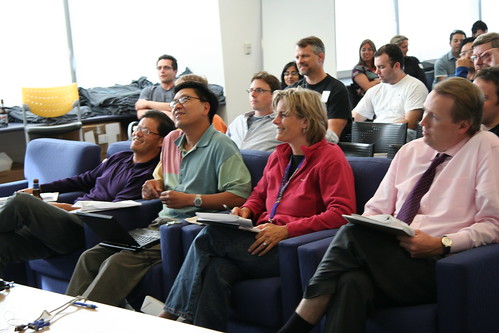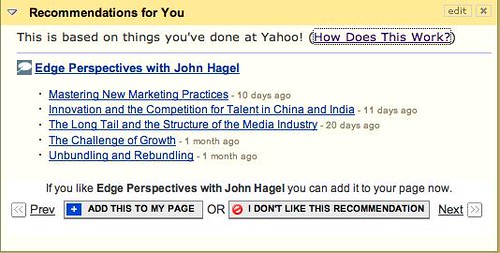See it on Yahoo! Video. And more photos of the event on Flickr, too.
Good times.
See it on Yahoo! Video. And more photos of the event on Flickr, too.
Good times.
Upon returning recently from a relaxing two-week holiday in Italy with my family, I found myself looking at an opportunity to join Chad Dickerson’s Yahoo! Developer Network team as a Product Manager. What a nice way to re-enter the real world after a break.
 With a clutter-free mind, it took me about 2 seconds to figure out that this was my chance to do many of the things at Yahoo! that I’ve wanted to do since joining the company last year. And the chance to work closely with Chad again was a huge incentive.
With a clutter-free mind, it took me about 2 seconds to figure out that this was my chance to do many of the things at Yahoo! that I’ve wanted to do since joining the company last year. And the chance to work closely with Chad again was a huge incentive.
He and his boss Bradley Horowitz have opened up several innovative and very successful paths for Yahoo! including the new open Hack Day. Watching the excitement around that event build, it’s obvious that there’s a lot more that can happen there. I’ll also get to work more closely with Jeremy Zawodny who has been a key evangelist and one of the most important voices for the company.
The idea of Yahoo! technologies opening up as services is picking up a lot of momentum. It’s an important opportunity that we have to get right, and we’re getting more organized to keep up with demand. We also have to listen more carefully to what people want from us. YDN is a great way to catalyze discussions amongst developers using Yahoo! services and to open up broader dialog with Yahoo! teams.
I’ve already started digging into the data that’s available, and it’s obvious that Yahoo! Developer Network is on a serious growth path. Site traffic is rising. The blog is buzzing. API keys are flying out the door. And more and more Yahoo! APIs are getting released and at increasing speed.
It’s a fascinating time to be here, and I hope I can help the company both reach and push its potential in this new role. Thanks, Chad.
After observing several Hack Day presentations and conducting a few screencasts of my own now, I think I’m seeing a formula for doing a 90-second demo.
 |
No format will replace charisma. And charisma won’t make a bad demo good. But these guidelines might at least give the presenter a baseline. And I’m sure this will help people who are competing at Hack Day.
People can usually articulate more than two words per second without sounding like one of the Kingsmen, but that doesn’t leave any room for dramatic pauses or potential hiccups in the presentation. So, a good 90-second demo will probably come out to maybe 150 words.
What can you communicate in 150 words? Not much.
The meat of the demo obviously must consist of a walk-through, but it’s often the beginning and end that screw up the whole thing.
The most common mistake is a poorly balanced intro that either drags on too long and makes the audience anxious or one that is too short and forces the audience to contextualize things in their own heads when they should be following what you’re saying.
Spend little or no time introducing yourself. Save that for the end. But spend 20 seconds defining the problem. Answer these questions:
Then get to the meat. Step the audience through a story one click at a time. Show a screen. Explain what is being shown. And then describe what will happen next. Tell them where you plan to click or what action you’re going to take and then do it. Explain the result and then repeat, one action at a time.
If at all possible, build the story to a climax. Each step from click to click should get progressively more interesting. At least point out the less dramatic elements of the demo first and build to the most exciting ones at the end. At about 80 seconds, you want to reveal the POW that will get everyone clapping.
If you get your POW before 80 seconds, great. Crack a joke and get off the stage. Don’t drag it out if you’re already done.
If all goes well, eyes will light up and cheers will wash over you.
Finally, close with some kind of contact information. Announce your name and the name of your demo during the applause, and leave before the applause finishes.
Here are a few hints that might also help:
There are lots of common public speaking tactics to take with you on stage, too, but I would never proclaim to be an expert in that.
Those who can’t do, teach.
Lastly, here are some interesting resources on presenting:
One of the more interesting hacks at Yahoo! Hack Day last week was a game that challenged the notion of tagging.
 |
How effective is tagging for recall? Can you remember what you tagged any given item? This question gets right to an important issue.
del.icio.us was invented as a type of bookmark manager. Joshua Schachter needed a way to save web pages, and the tag format seemed like a better metaphor than folders for recalling things.
When I first heard about del.icio.us from Jon Udell, my initial reaction to the idea of a bookmark manager was very negative. That reaction was clearly related to this question, as I was sure then and just as sure today that my mother will never organize her web pages with tags.
(Actually, that’s a risky statement. My mother is so organized that she can locate my primary school grade reports as quickly as she can find her most recent ATM receipt. She may actually become a super tagger some day.)
The act of tagging for the purpose of saving items for later is not for everyone. It is perhaps only necessary for a small group of people in specific circumstances. Bradley Horowitz’s influencer pyramid is a great visualization of how tagging can add value for the rest of us. At the top is the person who makes extra effort to evaluate, filter, categorize and socialize things. This is the person everyone who wants something socialized on the Internet needs to talk to.
In my mind, tags are hugely valuable. They expose important meta data at an abstraction level that was previously hidden in the Internet user interface. They are connective tissue allowing data sources to talk to each other in meaningful ways. And human-edited tags can balance the inaccuracies of machine automation that happens in any indexing exercise.
What’s missing from the tagging world is automatic learning. People shouldn’t have to find the ‘save’ button, click it, fill in tags, and hit save. My browser history says a lot about what interests me. The time I spend on a page says a lot about what I value. Any social activities I initiate or receive can inform a machine what the world around me thinks about.
The influencer is clearly willing to work harder to ensure information flows through the Internet in sensible ways, but everyone else will need something more personal to happen as a result of tagging to warrant the amount of effort to do it.
The introduction of tagging into the Internet user interface was a key step in the evolution of the medium, but the process of adding and collecting tag information needs to evolve before the effects of the tags will reach their true potential.
Last week’s Yahoo! Hack Day was, as usual, an eyeopener. In addition to the creative hacks, I was hugely impressed that the co-founder of the company and CFO among several other key executives spent an uninterrupted afternoon watching and then judging all the hacks.
 Photo: Yodel Anecdotal |
The only other model for bridging the gap between top brass and ground troops that I’ve seen work successfully was at IDG when founder Pat McGovern conducted his annual handshake around the world during the holidays. He meets with every single employee of the company (2k plus), shakes hands, chats for a few minutes and, if available, hands the employee his or her bonus. He remembers impressive details from previous conversations and clearly challenges himself to make a tangible connection with each person’s contribution.
Everyone admits that it creates awkward moments, but the effort is appreciated by all and wins him both loyalty and credibility across the whole company.
At Hack Day, I expected Jerry Yang and Sue Decker to spend much of their time on their phones while engineers were working their hardest to impress the crowds. Admittedly, I didn’t make it through the whole afternoon undistracted, but the judges were engaged in every presentation that I did see. No doubt they were paying attention and learning things that will impact their future decision-making.
There’s always the question of whether the hackers are motivated more by peers or by bosses. In either case, the 90-second demo format is the closest thing software development has to the clean and jerk. I’m not sure I’d call it chest-thumping exactly, but don’t believe for a second that every hacker doesn’t hope to beat his colleagues with the better hack.
I’ve probably changed my browser’s default home page about 10 times in the last year. Something about working here at Yahoo! has made me very picky about start pages.
 I most recently was using Netvibes which had a couple of really cool modules: a notes box that you could write in just by clicking in it and a sudoku puzzle that I would play on the train ride home. Unfortunately, Netvibes became way too slow for me. I found myself typing in a new URL before Netvibes came up every time I launched a browser window or clicked ‘home’.
I most recently was using Netvibes which had a couple of really cool modules: a notes box that you could write in just by clicking in it and a sudoku puzzle that I would play on the train ride home. Unfortunately, Netvibes became way too slow for me. I found myself typing in a new URL before Netvibes came up every time I launched a browser window or clicked ‘home’.
I don’t think Netvibes is alone in learning the hard lesson of scaling personalization features. It’s clear that NewsAlloy is struggling under the weight of their usage, and Rojo recently rescued their ailing infrastructure, at least we hope, by adopting a new parent in MovableType.
Even more dramatic is the performance on Wizag. Wizag is one of the most promising start pages I’ve seen yet with its learning and categorization concepts. The design is awful and the speed is unusable, but those problems are easier to solve than developing really new and interesting algorithms. I’m hoping they figure these things out, because I would love to use it more.
Not too long ago I tried switching to Google’s Personalized page. I loved the integration with my phone. You can select modules from your personalized start page that will appear on the phone version. It’s really smart. And it made me try using Google Reader more. But Google Reader is just not the way I want to work with my feed sources, and I got too annoyed.
Why not use My Yahoo! as your browser home page, you ask? I use My Yahoo!, actually. At least weekly. But it shares a problem I have with all personalized start pages…I want my browser to open with something that I don’t know. I want it to lead me, sometimes just a little bit.
And I just learned when I switched to the new Yahoo! home page that I want big pictures, too.
The new Yahoo! home page is brilliant. It has everything I actually want just prior to starting a journey somewhere or even when I’m not sure where to start. I can see the most recent email messages without having to open the full email app. I can check out traffic in my neighborhood, send a quick IM, search and get to my feeds (on My Yahoo!) all from the same place with minimal effort.
But what I love most is that the Yahoo! home page shows me stuff that I don’t know. The top stories have huge impact. They’re inviting, and they make me want to click. And the pulse box always catches my attention with the Top 10 this and Top 10 that.
One of the proven rules in magazine cover selling at the newsstand is that people love top 10 lists. It’s true online, too.
We also learned at InfoWorld how powerful imagery can be when we studied people’s eye movements on a more image-driven home page. The results of that study are here.
No doubt, I’ll switch home pages again soon. I haven’t stuck with one page for more than a few months, but I also don’t remember being as pleased as I am with this page. The dust has settled from the launch earlier in the summer, and I have to agree with what most people in the industry said: The new Yahoo! home page rocks.
Jay Rosen’s recent attack on Fortune columnist Justin Fox reminded me that changing old media’s role in this new world is not going to happen by telling them that they stink.
 Photo: carradine65 |
He accused Justin of failing to say anything meaningful in the ‘private vs public ownership of media’ debate. Underneath it all, however, was the more acidic accusation that Justin doesn’t get the Internet:
Justin then responded in depth to Jay, defending the accusations point by point on his new blog:
I’m as guilty as the next new media nerd of pressing old media to change their ways based on my own small view of the present and future challenges. I’m equal parts idealist and pragmatist, almost always the former when blogging.
But I also know that there are many editors and executives alike who wish very much to apply the mental shift they may have adopted perhaps years ago and turn it into practical change without losing their jobs in the process. We need those people employed and making change happen in their organizations in order to accomplish the new media goals, no matter how slowly.
As Justin points out, even Time Warner has adopted a multi-threaded approach to journalism where columnists are required to post weekly online in addition to their print columns which require significantly more dedication. If that’s not enough, Justin has recently begun blogging on topic and wrote a book on one of his beats to boot.
Time Warner may not be collaborating with customers as much as it needs to, but clearly that door is opening some. And that’s a good thing.
Jay is not wrong to press old media to change more dramatically and to do it faster. It’s not just the methods that need to change. The way that they think about the world around them and the value of their perspective both need to accomodate a new and different way of communicating.
In this case, it’s a matter of picking which battles to fight. Attacking those who are influencing positive change at the companies you wish to influence is probably going to turn off those who may be listening to you.
Don’t invite other kids to play in the sand box and then throw sand at them, Jay.
It’s hard to resist adding my $0.02 in a debate about blogging like the one Nick Carr started this week with his post on The Great Unread, the story of the royal hierarchy in the blogosphere:
“As the blogophere has become more rigidly hierarchical, not by design but as a natural consequence of hyperlinking patterns, filtering algorithms, aggregation engines, and subscription and syndication technologies, not to mention human nature, it has turned into a grand system of patronage operated – with the best of intentions, mind you – by a tiny, self-perpetuating elite.”
It’s definitely worth a read if you blog. If you don’t, it’s more echo chamber music, as is this post.
I suspect that the idea of the blogosphere and the blog elite is a temporary one. The blogger hierarchy does not make the substance of a post any more or less valuable. Ultimately, that value is completely up to me, not some shallow power structure.
I’m hoping that instead of reinforcing global hiearchical power structures that things like recommendation engines, personalization services, syndication and filtering algorithms will weed out the crap and bubble up what matters to me, empowering me to own my media experience.
Popular blogs, podcasts and videos will become just a sidebar to my daily intake when their relevance to my world is only tangential.
I respect what Jay Rosen says (and Nick, for that matter), but his posts are too long for me. I need the blogs I read regularly to filter out which of Jay’s posts are worth spending the time to read. I’m impressed not just by the quality of the posts Jeff Jarvis generates but also the volume. Again, I need an interestingness filter on Jeff’s posts to surface the ones that matter to me.
Yet all of Jay’s and Jeff’s influence on my thinking about journalism and media has no bearing whatsoever on the music I listen to, the basketball teams I follow or the technologies I find interesting.
What Nick rightly points out is that there will be an increasing tendency for people to publish for the sake of fame and fortune which will dilute the pool of interesting things out there. This is the popularity problem.
Perhaps I’m just optimistic. But it seems reasonable to expect that we’ll find technology answers to this issue, automatic ways to subvert wasteful power structures that may be forming in the world of personal media.
Former Yahoo! colleague Don Loeb (now at Feedburner) called out the recent addition of RSS feed recommendations to the My Yahoo! product. This module automatically bubbles up sources that you might want to add to your page so that you don’t have to hunt and peck so much to find stuff that matters to you.

It’s cool to see a technology work as it was intended…but then there are the surprises that aren’t intended that are even better than seeing something go as planned.
One interesting unintended outcome is that I’m actually discovering new blog posts to read that I would never otherwise find amongst my current list of feeds. And I don’t have to subscribe to the feeds to see these posts.
For example, Niall Kennedy’s blog was recommended to me in this new module and I learned that he’d just left Microsoft after a short stay with the Live.com team. I don’t currently subscribe to Niall’s blog and none of my feeds seemed to reference this news. Very impressive.
This is another example of the “Interestingness” concept Tim O’Reilly and Bradley Horowitz have written about this week.
You can get access to the recommendations module by clicking on the small promotional link in the “Inside My Yahoo!” module that comes as a default when you sign up for an account. The reason we’re not making more noise about this pilot is because we’re in test mode to see if it works and if people like it. Plus, it feels like the kind of feature you just expect from a personalized start page anyhow.
I find it a bit presumptuous that someone would try to end a discussion on a topic in the blogosphere or, for that matter, assume that they drive a conversation in the market.
In an attempt to stop people blabbing endlessly about bloggerism vs journalism, Steven Berlin Johnson redefined the 5 points of the debate, recapping Jay Rosen’s closing arguments on the topic from over a year ago. His post was a response to Nichalos Lehmann’s article Amateur Hour — Journalism without journalists in The New Yorker questioning the value of blogging:
“Jay Rosen tried to kill off this kind of discussion a year or two ago with his smart essay, Bloggers Versus Journalists Is Over, but obviously it didn’t stick. So let me propose a slightly more blunt approach.”
Similarly, it seems odd to me that Malcolm Gladwell has decided that blog commentary is merely derivitive of mainstream media conversation:
“Any form that consists, chiefly, of commentary and criticism is derivative. We need derivative media sources to help us make sense of what we learn from primary sources.
…although it maybe possible for some bloggers to think of their thoughts as rising, fully formed, from the blogosphere, it just ain’t so. Even people who do not think of themselves as being influenced by the agenda of traditional media actually are: they are simply influenced by someone who is influenced by someone who is influenced by old media.”
He makes this statement in response to Chris Anderson of Long Tail fame (and Conde Nast’s Wired magazine). Chris used a comment Malcolm made to reinforce the point that mainstream media is not as powerful as it thinks it is:
“What we do has great value, but we no longer have a monopoly on leading the public conversation (not that we ever did, of course, but it was easier to delude ourselves before). The blogosphere doesn’t need us to give them something to talk about. When we do what we do well and add new ideas, information and analysis, blogs can be our best friend, amplifying our reach many-fold. But when we don’t, the former audience is very happy to talk amongst itself.”
There’s a bit of chicken and egg here, as I’m not sure it’s clear whose work is derivitive of whose.
A good reporter is a story teller of other people’s experiences. Nothing in the Wall Street Journal happens because the Wall Street Journal said it did. A good media company like the Wall Street Journal is able to catalyze important events and thinking happening in interesting places into meaningful and valuable chunks with a consistent lens, and there’s no doubt the Wall Street Journal influences what people think about.
But that role in not exclusive, even when their coverage of a topic is considered the best in its class or costs a ton of money or takes a lot of research to get right.
The conversations the Wall Street Journal covers are reflections of conversations that in many cases started years prior, and it’s not until the topic reaches some kind of tipping point does the Wall Street Journal then translate it for their lens of the world.
I would never deny being influenced by mainstream media. But that’s more a result of the fact that I have shared experiences with people than because the influence is meaningful or relevant. In fact, it becomes less and less relevant the more my media experience diversifies.
I agree with Steven that this particular topic lacks the juice it used to have. Jay Rosen has done a brilliant job of turning the discourse into a cohesive string that matters and feels complete from my personal perspective and obviously for Steven’s.
But closure for us may also mean it’s time for some fresh perspective to alter the dialog or extend it in sensible ways for other people yet untouched by it or confirm the premise of the argument with more useful research.
The effects of disintermediating media are still unfolding, and I’m betting that leaders at most big media companies will get more clarity on how to deal with that problem from each other and the individuals they know at competing companies or even their neighbors than they will from reading about it in their own publications.